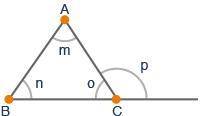
Mathematics, 22.10.2020 14:01 573589
PLZ HELP
A student writes an incorrect step while checking if the sum of the measures of the two remote interior angles of triangle ABC below is equal to the measure of the exterior angle.
Step 1: m∠m + m∠n + m∠o = 180 degrees (sum of angles of a triangle)
Step 2: m∠p − m∠o = 90 degrees (alternate interior angles)
Step 3: Therefore, m∠m + m∠n + m∠o = m∠o + m∠p
Step 4: So, m∠m + m∠n = m∠p
In which step did the student first make a mistake and how can it be corrected? (4 points)
a
Step 1; it should be m∠m + m∠n + m∠o = 90 degrees (corresponding angles)
b
Step 1; it should be m∠m + m∠n + m∠o = 90 degrees (adjacent angles)
c
Step 2; it should be m∠o + m∠p = 180 degrees (alternate exterior angles)
d
Step 2; it should be m∠o + m∠p = 180 degrees (supplementary angles)
I think its c


Answers: 3
Another question on Mathematics

Mathematics, 21.06.2019 16:40
Which of the following is the correct equation for this function? a. y= (x+4)(x+2) b. y=x^2+ 3x – 2 c. y+ 2 = – 2(x+3)^2 d. y+ 2 = 2(x+3)^2
Answers: 1


Mathematics, 21.06.2019 19:20
Suppose that a households monthly water bill (in dollars) is a linear function of the amount of water the household uses (in hundreds of cubic feet, hcf). when graphed, the function gives a line with slope of 1.65. if the monthly cost for 13 hcf is $46.10 what is the monthly cost for 19 hcf?
Answers: 3

Mathematics, 21.06.2019 22:30
Amachine that produces a special type of transistor (a component of computers) has a 2% defective rate. the production is considered a random process where each transistor is independent of the others. (a) what is the probability that the 10th transistor produced is the first with a defect? (b) what is the probability that the machine produces no defective transistors in a batch of 100? (c) on average, how many transistors would you expect to be produced before the first with a defect? what is the standard deviation? (d) another machine that also produces transistors has a 5% defective rate where each transistor is produced independent of the others. on average how many transistors would you expect to be produced with this machine before the first with a defect? what is the standard deviation? (e) based on your answers to parts (c) and (d), how does increasing the probability of an event a↵ect the mean and standard deviation of the wait time until success?
Answers: 3
You know the right answer?
PLZ HELP
A student writes an incorrect step while checking if the sum of the measures of the two re...
Questions























